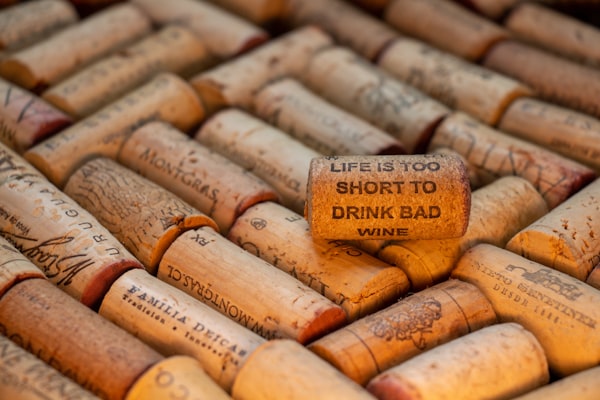Cooking wine is a common ingredient found in many recipes, especially those that require a splash of wine to add flavor. But can you drink cooking wine? The answer is yes, you can technically drink cooking wine. However, it is not recommended due to its high salt content and added preservatives.
Cooking wine is not the same as drinking wine. It is made specifically for cooking and contains added salt and preservatives to extend its shelf life. Drinking cooking wine can result in an unpleasant taste due to its high salt content, and it is not recommended for consumption as a beverage. However, some people do use cooking wine as a substitute for drinking wine in recipes, as it can provide a similar flavor profile without the alcohol content.
Overall, while it is technically possible to drink cooking wine, it is not recommended due to its high salt content and added preservatives. It is best to use cooking wine solely for its intended purpose - as an ingredient in recipes.
Understanding Cooking Wine
What is Cooking Wine
Cooking wine is a type of wine that is specifically made for cooking purposes. It is different from regular drinking wine since it has added salt and other flavorings, making it unsuitable for drinking. Cooking wine is usually cheaper than drinking wine, and it is sold in most grocery stores.
Ingredients in Cooking Wine
Cooking wine is made from regular drinking wine, but it has additional ingredients such as salt, herbs, and other flavorings. The added salt makes cooking wine unsuitable for drinking, and the herbs and other flavorings give it a unique taste that complements various dishes.
Alcohol Content in Cooking Wine
Cooking wine has a lower alcohol content compared to regular drinking wine. The alcohol content in cooking wine is usually around 16% ABV (alcohol by volume), while regular drinking wine has an ABV of between 12% and 14%. The lower alcohol content in cooking wine makes it less suitable for drinking.
Cooking Wine Varieties
Cooking wine comes in different varieties, including red and white cooking wine. Red cooking wine is made from red grapes, while white cooking wine is made from white grapes. Other varieties of cooking wine include sherry, rice wine, and mirin.
When using cooking wine in recipes, it is essential to choose the right variety that complements the dish. For example, red cooking wine is suitable for red meat dishes, while white cooking wine is ideal for white meat dishes.
In conclusion, cooking wine is a type of wine that is specifically made for cooking purposes. It has added salt and other flavorings, making it unsuitable for drinking. Cooking wine has a lower alcohol content compared to regular drinking wine, and it comes in different varieties, including red and white cooking wine.
Comparison with Regular Wine
When it comes to drinking wine, there are many options available, but can you drink cooking wine? To answer this question, it's important to understand the differences between cooking wine and regular wine.
Cooking Wine Vs Drinking Wine
Cooking wine is typically made with low-quality grapes and contains added salt and preservatives, making it unsuitable for drinking. Regular wine, on the other hand, is made with high-quality grapes and is fermented without added salt or preservatives, making it safe and enjoyable to drink.
Sweet Wines
Sweet wines are a popular choice for those who prefer a sweeter taste. However, cooking wine is not a good substitute for sweet wine, as it lacks the sweetness and complexity found in sweet wines.
Dry Wines
Dry wines are those that contain little to no residual sugar. Cooking wine can be used as a substitute for dry wine in cooking, but it lacks the depth and complexity found in high-quality dry wines.
Table Wines
Table wines are those that are typically served with meals. While cooking wine can be used in recipes that call for table wine, it is not recommended to serve cooking wine as a table wine due to its low quality and added salt and preservatives.
In conclusion, while cooking wine can be used in recipes that call for wine, it is not suitable for drinking due to its low quality and added salt and preservatives. Regular wine, on the other hand, is made with high-quality grapes and is fermented without added salt or preservatives, making it safe and enjoyable to drink.
Health Implications of Drinking Cooking Wine
Sodium Content
Cooking wine has a high sodium content, which can lead to health problems. According to Chef's Vision, cooking wine has about 20% more sodium than regular wine. This means that drinking cooking wine can increase your daily sodium intake, which can lead to high blood pressure, heart disease, and stroke.
Health Risks
Drinking cooking wine can have serious health risks. As UpThirst notes, cooking wine has a high alcohol content, which can lead to alcohol poisoning if consumed in large quantities. Additionally, cooking wine may contain chemicals and preservatives that are not safe for human consumption.
Effect on Weight
Cooking wine is not a low-calorie drink. According to Make Home Wine, cooking wine has about the same number of calories as regular wine. However, cooking wine is often consumed in larger quantities than regular wine, which can lead to weight gain over time.
Heart and Kidney Problems
Drinking cooking wine can lead to heart and kidney problems. As Dr. Weil notes, drinking moderate amounts of wine can protect against heart disease and heart attack. However, drinking cooking wine is not the same as drinking moderate amounts of wine. Cooking wine has a high sodium content and may contain chemicals and preservatives that can damage the heart and kidneys over time.
In conclusion, drinking cooking wine is not recommended due to the high sodium content, health risks, effect on weight, and potential for heart and kidney problems. It is best to stick to drinking regular wine in moderation for the health benefits.
Taste and Flavor Profile of Cooking Wine
Cooking wine is a type of wine that is specifically made for cooking purposes. It is not meant to be consumed as a beverage due to its taste and flavor profile. In this section, we will explore the taste and flavor profile of cooking wine.
Saltiness
Cooking wine is known for its saltiness. This is because it contains added salt to help preserve it and give it a longer shelf life. The saltiness can be overpowering and make the wine unpleasant to drink. However, when used in cooking, the saltiness can enhance the flavor of the dish.
Earthiness
Cooking wine has an earthy flavor profile. This is due to the fact that it is made from grapes that are not of the highest quality. The earthiness can add depth and complexity to a dish when used in cooking.
Oakiness
Cooking wine is not aged in oak barrels like traditional wine. Therefore, it lacks the oakiness that is associated with traditional wine. This can make it less desirable to drink but can still add a subtle flavor to a dish when used in cooking.
Aromas
Cooking wine has a pungent aroma that is not desirable for drinking. The aroma can be described as acidic and vinegary. However, when used in cooking, the aroma can add a depth of flavor to a dish.
In conclusion, cooking wine has a distinct taste and flavor profile that is not meant for drinking. It is saltier, earthier, and lacks the oakiness of traditional wine. The aroma is pungent and acidic, but it can add depth to a dish when used in cooking.
Cooking with Wine
Cooking with wine can add depth and complexity to a dish, but it can also be a bit intimidating if you're not familiar with the process. Here are some tips and recipes to get you started.
Cooking Process
When cooking with wine, it's important to choose the right wine for the job. Generally, you want to use a dry wine with good acidity, as this will help balance out the flavors in your dish. White wine is best for lighter dishes like fish and chicken, while red wine is better for heartier dishes like stews and braises.
When adding wine to a dish, you want to do it early on in the cooking process so that the alcohol has time to cook off and the flavors have time to meld together. You can add it at the beginning of the cooking process, or you can add it towards the end to deglaze the pan and create a sauce.
Recipes Using Wine
Wine is a great ingredient to use in a variety of dishes, from sauces to stews to soups. Here are a few recipes to get you started:
Tomato Bisque: Saute onions and garlic in butter, then add canned tomatoes, chicken broth, and a cup of dry white wine. Simmer for 20 minutes, then puree and season with salt and pepper.
Coq au Vin: Brown chicken in a Dutch oven, then remove and set aside. Saute onions, carrots, and celery in the same pot, then add a cup of red wine and deglaze the pan. Add chicken back to the pot along with chicken broth, thyme, and bay leaves. Simmer for an hour, then serve over mashed potatoes.
Beef Stew: Brown beef in a Dutch oven, then remove and set aside. Saute onions, carrots, and celery in the same pot, then add a cup of red wine and deglaze the pan. Add beef back to the pot along with beef broth, potatoes, and herbs. Simmer for two hours, then serve with crusty bread.
Best Wine for Cooking
When it comes to cooking with wine, you don't want to use anything too expensive or too sweet. Here are a few good options:
Chardonnay: This dry white wine is great for lighter dishes like fish and chicken.
Pinot Noir: This light-bodied red wine is great for dishes that don't require a lot of cooking time, like tomato bisque or coq au vin.
Cabernet Sauvignon: This full-bodied red wine is great for heartier dishes like stews and braises.
Remember, when cooking with wine, you want to use something that you would also enjoy drinking.
Storage and Shelf Life of Cooking Wine
Expiration Date
Cooking wine has a longer shelf life than regular wine because of the added salt and preservatives. According to Eat Delights, unopened cooking wine can last for 3 to 5 years past its "Best Before" date. However, once opened, cooking wine should be used within a few months to avoid spoilage and loss of flavor.
It is important to note that the "Best Before" date on cooking wine is not an expiration date. It is a recommendation for when the wine is at its best quality. The wine may still be safe to consume after this date, but the flavor and quality may deteriorate over time.
Recommended Wine Storage
Proper storage is essential to maintain the quality of cooking wine. Cooking wine should be stored in a cool, dark place away from direct sunlight and heat. Exposure to heat and light can accelerate wine oxidation, which can cause the wine to spoil faster.
It is also recommended to store cooking wine in an airtight container or a wine bottle with a tight-fitting cork to prevent air from getting in. Air can cause the wine to oxidize, which can lead to spoilage and loss of flavor.
To prevent spoilage, it is best to use cooking wine within a few months of opening. Once opened, cooking wine should be stored in the refrigerator to prolong its shelf life. However, it is important to note that the taste of the wine may change after being refrigerated, so it is best to use it as soon as possible.
In summary, cooking wine has a longer shelf life than regular wine due to added salt and preservatives. Proper storage is crucial to maintain the quality of cooking wine and prevent spoilage. Once opened, cooking wine should be used within a few months and stored in the refrigerator to prolong its shelf life.
Conclusion
In conclusion, while it is technically possible to drink cooking wine, it is not recommended. Cooking wine is not intended for drinking and can be harmful to consume in large quantities.
Cooking wines are often high in sodium and contain preservatives that can be harmful to the body. Additionally, cooking wines are often sugar-free and have less flavor than drinking wine, which can make them unpleasant to drink.
While some people may argue that drinking cooking wine is safe in moderation, it is important to remember that cooking wine is not intended for drinking and should be used only for cooking purposes.
Overall, it is best to avoid drinking cooking wine and instead opt for a quality drinking wine if you are looking to enjoy a glass of wine. If you are unsure about the safety of drinking a particular cooking wine, it is always best to err on the side of caution and avoid consuming it altogether.









Member discussion